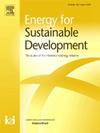Strategic optimization of electric vehicles' battery swapping stations for developing countries: Balancing demand, cost dynamics, and sustainability in electric mobility
IF 4.9
2区 工程技术
Q2 ENERGY & FUELS
引用次数: 0
Abstract
This study presents a stochastic planning framework for battery swapping station (BSS) networks tailored to developing countries. The mixed-integer model co-optimizes siting and operations for interconnected stations while capturing uncertainties in electric vehicle (EV) arrivals, energy prices, electrical load, and degradation cost. A 24-h scenario study on the IEEE 33-bus feeder uses a normalized probability distribution function (NPDF) and retains the 10 most-probable scenarios. Location matters: placing a single station near the source (Bus 1) yields a total network cost $11,886.61, whereas installing at Bus 33 increases the cost to $12,065.92 but raises operator profit from $8111.82 to $8753.89 via fewer discharge cycles. With one station (Bus 2), energy arbitrage injects 7.5 MW and 5.3 MW at peak hours 15–16. Splitting capacity across two stations (Buses 2 and 10) improves service: Station 10 charged 700 batteries and served 222 EVs, while Station 2 exchanged 9.975 MW with the grid. Under uncertainty, purchased power rises modestly; total network cost increases from $11,894.13 to $11,912.09, while profit grows to $8156.62. Sensitivity analyses show that higher initial charged inventory and larger interconnection capacity reduce system cost and increase profit. The framework offers actionable siting and operating guidance for equitable, cost-aware BSS deployment.
发展中国家电动汽车电池交换站的战略优化:平衡需求、成本动态和可持续性
本研究提出了一个适合发展中国家的电池交换站(BSS)网络的随机规划框架。混合整数模型在捕捉电动汽车(EV)到达、能源价格、电力负荷和退化成本等不确定性的同时,共同优化了互联车站的选址和运营。对IEEE 33总线馈线的24小时场景研究使用归一化概率分布函数(NPDF)并保留了10个最可能的场景。位置很重要:在源头(1号总线)附近放置一个站点,总成本为11,886.61美元,而在33号总线上安装一个站点,成本增加到12,065.92美元,但通过减少放电周期,运营商的利润从8111.82美元增加到8753.89美元。通过一个站(2号总线),能源套利在高峰时段15-16注入7.5兆瓦和5.3兆瓦。将容量分配到两个站点(2号和10号公交)改善了服务:10号站为700块电池充电,为222辆电动汽车提供服务,而2号站与电网交换了9.975兆瓦的电量。在不确定性下,购买力温和上升;总网络成本从11,894.13美元增加到11,912.09美元,而利润增长到8156.62美元。敏感性分析表明,初始收费库存越高,互联容量越大,系统成本越低,利润越高。该框架为公平、有成本意识的BSS部署提供了可操作的选址和操作指导。
本文章由计算机程序翻译,如有差异,请以英文原文为准。
求助全文
约1分钟内获得全文
求助全文
来源期刊

Energy for Sustainable Development
ENERGY & FUELS-ENERGY & FUELS
CiteScore
8.10
自引率
9.10%
发文量
187
审稿时长
6-12 weeks
期刊介绍:
Published on behalf of the International Energy Initiative, Energy for Sustainable Development is the journal for decision makers, managers, consultants, policy makers, planners and researchers in both government and non-government organizations. It publishes original research and reviews about energy in developing countries, sustainable development, energy resources, technologies, policies and interactions.
 求助内容:
求助内容: 应助结果提醒方式:
应助结果提醒方式:


